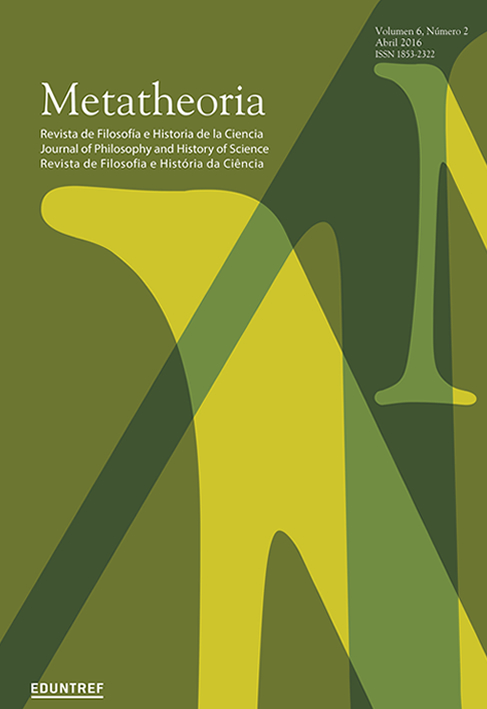Some Relations between the Confirmation Holism and Semantic Holism: A Case Study
DOI:
https://doi.org/10.48160/18532330me6.253Keywords:
confirmation holism, semantic holism, natural selection theory, population geneticsAbstract
The thesis of the confirmation holism appears for the first time explicitly and extensively in the writings of Duhem. Years later, it is defended by Quine, but not based on the discussion of particular scientific theories, but in relation to its semantic position. Since then, the relations between semantic holism and confirmation holism have been discussed, although generally somewhat detached from the analysis of specific theories and their relations. I intend to show from the analysis of a case, that of the relations between population genetics and the theory of natural selection, a sense in which the holism of confirmation can be derived from semantic holism.
References
Ariew, R. (1983), “The Duhem Thesis”, British Journal for the Philosophy of Science35: 313-325.
Balzer, W., Moulines, C.U. y J.D. Sneed (1987), An Architectonic for Science–The Structuralist Program, Dordrecht: Reidel. (Versión castellana de Pablo Lorenzano: Una arquitectónica para la ciencia. El programa estructuralista, Bernal:Universidad Nacional de Quilmes, 2012.)
Barbadilla, A. (1990), “La estructura de la teoría de la selección natural”, en Ruiz, A. y M. Santos (eds.), Temas actuales de Biología Evolutiva, Barcelona: UAB, pp. 163-191.
Blanco, D. (2008), “La naturaleza de las adaptaciones en lateología natural británica: análisis historiográfico y consecuencias metateóricas”, Ludus Vitalis16(30):3-26.
Darwin, C. (1872), The Origin of Species, 6aed.,London: John Murray.Devitt, M. (1993), “A Critique of the Case for Semantic Holism”, Philosophical Perspectives7: 281-306.
Duhem, P. (1914), La théorie physique: son objet et sa structure (deuxième édition),Paris: Marcel Rivière & Cte, éditeurs.
Endler, J. A. (1986), Natural Selection in the Wild,Princeton, New Jersey: Princeton University Press.
Fodor, J. A. (1987), Psychosemantics,Cambridge: MIT Press.
Fodor, J. A. y E. Lepore (1992), Holism: A Shopper's Guide,Oxford: Blackwell.
Futuyma, D. J. (1986), Evolutionary Biology, 2aed.,Sunderland, MA: Sinauer Associates, Inc.
Gayon, J. (1998), Darwinism's Struggle for Survival: Heredity and the Hypothesis of Natural Selection,Cambridge: Cambridge University Press.
Gillies, D. (1998), Philosophy of Science in the Twentieth Century -Four Central Themes. Oxford/Cambridge: Blackwell.
Ginnobili, S. (2006a), “La selección natural como conjunto de hechos e inferencias”, en Ahumada, J., Pantalone, M. y V. Rodríguez (eds.), Epistemología e Historia de la Ciencia, Córdoba: Universidad Nacional de Córdoba, pp. 266-275.
Ginnobili, S. (2006b), La teoría de la selección natural darwiniana, Tesis de licenciatura, Buenos Aires: Universidad de Buenos Aires.
Ginnobili, S. (2007a), “Darwinismo universal de dominio de aplicación restringido”, en Martins, L. A.-C. P., Prestes, M. E. B., Stefano, W. y R. de A. Martins (eds.), Filosofia e história da biologia 2, São Paulo: Fundo Mackenzie de Pesquisa (MackPesquisa), pp. 427-443.
Ginnobili, S. (2007b), “Hay lo que queda. Sobre la presunta tautologicidad de la teoría de la selección natural”, Análisis Filosófico27(1): 75-89.
Ginnobili, S. (2009), “El poder unificador de la teoría de la selección natural”, en Barboza, M. C.,Avila, J. D.,Píccoli,C. y J. Cornaglia Fernández (eds.), 150 años después... La vigencia de la teoría evolucionista de Charles Darwin, Rosario: Universidad Nacional de Rosario, pp. 141-154.
Ginnobili, S. (2010a), “La teoría de la selección natural darwiniana”, Theoria25(1): 37-58.
Ginnobili, S. (2010b), “La teoría de la selección natural darwiniana y la genética de poblaciones”, Endoxa24: 169-184.
Ginnobili, S. (2011), La estructura de la teoría de la selección natural. Elucidación de sus conceptos fundamentales, reconstrucción de su estructura y consecuencias del análisis sobre algunas discusiones metateóricas a su alrededor, Tesis doctoral, Buenos Aires: Universidad de Buenos Aires.
Ginnobili, S. (por aparecer), “Selección artificial, selección sexual, selección natural”, Metatheoria.
Glymour, B. (2006), “Wayward Modeling: Population Genetics and Natural Selection”, Philosophy of Science73(4): 369-389.
Harrell, M. (1996), “Confirmation Holism and Semantic Holism”, Synthese109: 63-101.
Hempel, C. G. (1970), “On the 'Standard Conception' of Scientific Theories”, en Radner, M. y S. Winokur (eds.), Minnesota Studies in the Philosophy of Science, Minneapolis: University of Minnesota Press, pp. 142-163.
Lorenzano, P. (2005), “Ejemplares, modelos y principios en la genética clásica”, Scientiae Studia3(2): 185-203.
Lorenzano, P. (2008), “Bas C. van Fraassen y la ley de Hardy-Weinberg: una discusion y desarrollo de su diagnóstico”, Principia12(2): 121-154.
Lloyd, E. A. (1994), The Structure and Confirmation of Evolutionary Theory, New Jersey: Princeton University Press.
Moulines, U. (1991), Pluralidad y recursión,Madrid: Alianza.
Needham, P. (2000), “Duhem and Quine”, Dialectica54(2):109-132.
Putnam, H. (1998), “Meaning Holism”, en Hahn,L. E. y P. A. Schilpp (eds.), The Philosophy of W. V. Quine,ed. extendida, Chicago/La Salle: Open Court, pp. 405-426.
Quine, W. V. O. (1951), “Main Trends in Recent Philosophy: Two Dogmas of Empiricism”, The Philosophical Review60(1): 20-43.
Quine, W. V. O.(1998), “Reply toJules Vuillemin”, en Hahn, L. E. y P. A. Schilpp (eds.), The Philosophy of W. V. Quine, ed. extendida, Chicago/La Salle: Open Court, pp. 619-622.
Ruse, M. (1973), The Philosophy of Biology, London: Hutchinson & Co. Thompson, P. (1989), The Structure of Biological Theories,New York: State University of New York Press.
Vuillemin, J. (1998), “On Duhem's and Quine's Theses”, en Hahn, L. E. y P. A. Schilpp (eds.), The Philosophy of W. V. Quine,ed. extendida, Chicago/La Salle: Open Court, pp. 595-618.
Downloads
Published
How to Cite
Issue
Section
License
Copyright (c) 2020 Metatheoria – Journal of Philosophy and History of ScienceThe documents published here are governed by the licensing criteria
Creative Commons Argentina.Atribución - No Comercial - Sin Obra Derivada 2.5 https://creativecommons.org/licenses/by-nc-nd/2.5/ar/





